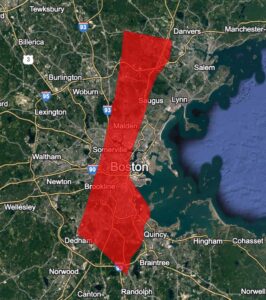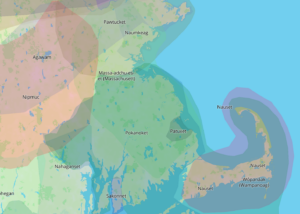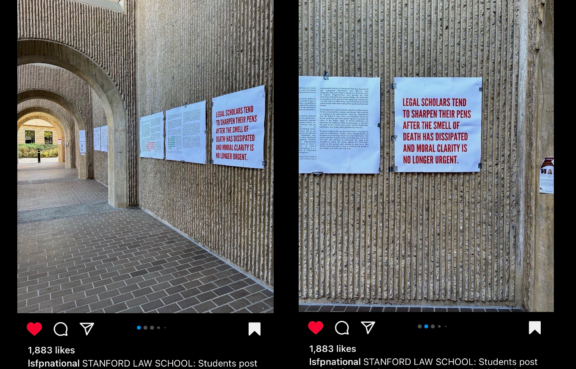This is a revised version of a talk delivered at the symposium “Palestine and the Historian” at Harvard University on a panel titled “Borders, Apartheid, Carcerality.”
My comrade Mary Jirmanus Saba—a filmmaker, geographer, and media studies scholar—recently participated in a conference where she presented a film titled “Mehdi Amel in Gaza, On the Colonial Mode of Production” in which she created a montage of Palestinian journalists reporting from the current genocide with past and present images of Gaza, along with the words of Lebanese philosopher and militant Mehdi Amel. She said of her experience on a panel called “Colonialism, Fanon, and Du Bois”:
Right before joining the Q&A over zoom…I had read @motaz_azaiza’s words: ‘It’s about life or death now. I did what I could. We are surrounded by the Israeli tanks.’ I tried to bring [Palestinian journalists] Motaz, Roshdi, Yaser, Bisan, and others to the room of this academic conference, using their words and images. But the renewed barbarity [in Gaza] left me speechless. I joined the zoom call nearly in tears. Instead of addressing the film, Gaza, or literal decolonization movement and genocide happening now in Palestine, the Q&A was entirely about theoretical questions on decolonization and revolution. Neither the moderator nor the audience directed any substantive questions to me or even uttered the word ‘Palestine.’ The moderator asked if I wanted to speak about the film, although the film had itself asked the audience, ‘what is our responsibility to Motaz, to Hani, to Roshdi, to Yaser, to Gaza.’ No one seemed interested in answering. Shocked, I mumbled some nonsense.
The organizers apologized and assured Mary that the problem was an awkward moderator and technical difficulties, not a lack of desire to speak of Palestine or engage with her film that had so moved the audience. The conference had also featured some other speakers on Palestine. Nonetheless, the issues Mary raised about her experience in an academic space is something we must consider. What is our role as intellectuals in the midst of genocide? While broader theoretical questions and concerns are essential to our work as scholars, we have to ask if they risk compromising our stance on colonial, imperial, and racist brutality. Do they become a security blanket to comfort our bodies and souls to keep the pain at bay or provide cover for those unwilling to take action? In other words, does the academy effectively work to enable complacency as we witness bodies being destroyed in real time? Academic scholarship seeks to add nuance; but, in fact, is what we are witnessing even that complicated?
If more context on Mary might help us better appreciate her words, know that she is an American of Lebanese and Palestinian descent whose family has been displaced twice—first during the unleashing of the Nakba in 1948 and then again during the Lebanon war in the 1980s. She is an alum of Harvard College, a place where she was harassed for being Palestinian. She said this of her experience: “I was made to understand there was no way for me to complain, Arabs are not a protected class, and the political climate at the time [the aftermath of 9/11] made such hate speech acceptable. With Larry Summers as President, there was no higher recourse for me at the University, and I learned to accept this kind of racialized harassment as normal and persist despite it.” This was the sober judgment of an eighteen-year-old at this institution.
So, I ask again, what is the role of the intellectual? Who is it that can speak in the midst of a genocide? Who is it that refuses to even utter the word Palestine? When it comes to our shared humanity, is Palestine the exception? These are some of the questions being posed to us by history graduate students in organizing this symposium—organized courageously because those of us without jobs and tenure know very well what this could mean for us down the road where protective laws don’t seem to apply for those who speak in support of Palestine or for those who are Palestinian. Discrimination and silencing abound in the academy. Despite this we are here, asking ourselves the question: what is our responsibility to Gaza and to Palestine?
As a historian and a Native Studies scholar on Turtle Island, I constantly think about my scholarly responsibilities and the relational responsibilities that this work demands and requires. Partly my upbringing and instincts and to a great extent my field have taught me that it is my responsibility to work towards being in good relation with this land, its waters and beings, to center Indigenous experiences and perspectives on the past, present, and future, to engage Native peoples in their struggles for self-determination, and to educate generations of students on the histories of Native survivance amidst ongoing settler colonialism while together imagining a postcolonial future.
I’m not sure when I first heard the term settler colonialism. It was sometime during graduate school but not in any of my history or American studies graduate courses. But when I did hear it, I knew what it meant without much effort. This was because I already knew the words “settler” and “settlements” from Palestine, and of the extraordinary violence and disinformation used to deny Palestinians not only their self-determination, but their very existence as a people. It immediately clicked, that is what happened in this place—a place where I migrated with my family at the age of four from England, which is a place where my family migrated from Punjab, which is a place that has been partitioned again and again and again. For far too many people life is this kind of run-on sentence. So we are here on Turtle Island—brought together through the violence and intimacies of European empires and their colonial offspring, by networks of capital that wreak havoc everywhere we look, and by the militarism that gives these networks their ghoulish lifeblood.
Growing up I understood the Americas as a colonized place, but until hearing the term settler colonialism, I had no framework to understand what happened and continues to happen here. In a nutshell, settler colonialism is a theory of Native elimination. Settler colonialism is part of a broader field of imperial power. It is an ongoing process—not an event that occurred in some distant past. It has two main components—genocide and erasure. Erasure is the attempt to assimilate Native peoples into the settler system of domination and the discursive denial of Native histories and homelands, and of the very existence of Native peoples as self-governing, self-determinative polities. This is all done with the hope that Native peoples will forget that they are Native.
But what happens when Native peoples and their Nativeness don’t disappear as expected or desired, when they resist and persist, and demand respect for the treaties, for their peoplehood, and their sovereignty, and demand their land back? One way the US and Canadian states answered this colonial problem—what settlers viewed as the “Indian problem”—is with state projects of removal, carceral confinements, and collective punishments, all designed to “reform” Native peoples of their indigeneity in order to securitize settler land theft and settler governance.
Resonances between Turtle Island and Palestine abound. We have heard Gaza described as an open-air prison. It is, at once, a part of Palestinian homelands and a place of spatial confinement where Palestinians need permission to leave to visit friends and relatives in the West Bank, where they have to carry permits, wait at checkpoints, amidst the pervasive threat of being rounded up and thrown into a settler prison. This includes children who are tried in military courts—that is, if they even receive due process within the colonial legal regime. The settler state controls access to water, food, energy, and the sea. Its occupation forces destroyed Gaza’s airport in 2001 during the Second Intifada. And the Port of Gaza has been under a naval blockade since 2007.
The image below shows an outline of Gaza superimposed on a map of Greater Boston (fig. 1). Now imagine living in this red zone under the control of a foreign entity. Caged by a wall. Your mobility restricted. Having to work for those who keep you caged to earn money to support your family. Going through checkpoints multiple times a day. Logan Airport bombed out. No access to the sea beyond three miles. Being bombed every few years while being told that you don’t exist and have never existed. Living for 75 years as refugees in your own homeland because settlers took your house, which still exists and is occupied by them beyond the red zone. Meanwhile, your twelve-year-old niece, who lives in another walled territory over in the Cape, is in a settler military prison because she stood up to an occupation soldier or threw a rock at a tank. This is a daily living reality in Palestine.

But there is something else to consider. Is there irony in the overlay of an outline of Gaza on the unceded lands of the Massachusett and Wôpanâak tribes? Do you know where these tribes are today? Do you know how Massachusetts became Massachusetts? If not, why not? Are you inclined to learn how this land was taken? If you are, what will you do once you find out? What is your responsibility to this land and its peoples? What is your responsibility to Gaza?

I was invited here to speak about carcerality, and so I will. This semester I taught a course titled “Indigenous America and Carceral Empire.” As the Israeli occupation forces began raining bombs on Gaza—in alleged retaliation to Hamas’s breach of territories occupied in 1948, and for taking hostages—my students and I were in the middle of our unit on “Land and Confinement.” We were just starting our first set of readings on Native removal. We were close reading treaties, a speech by Andrew Jackson as well as a report by an Indian Commissioner and looking at maps. We read the works of historians on removal as a genocidal process, on the relationship between white supremacy and the formation of Indian Territory, on incarceration and displacement. As bombs dropped on Gaza, it was eerie to read the words of Georgia’s white settlers justifying Cherokee removal, and Cherokees calling them out on their lies, even as the settler state framed their removal as a humanitarian solution. The resonances were almost too much to bear because for me—and for my students I would learn—colonialism and racism are not relegated to academic concerns and historical considerations; instead, these histories shape our daily lives and touch our deepest wounds because so little has been resolved. Rather than illuminate these continuities, academic conventions coerce us into silence. Meanwhile our Palestinian relatives are terrorized simply because they strive to end their subjugation. As historians, we know this has all happened before, which might make it easy for some of us to shrug our shoulders. As humans, however, it is daily anguish.
As the bombs continued to drop on Gaza, my students and I moved from Indian removal to the deportations of Dakhóta, their confinement in prison camps, and their subsequent executions in 1862. They faced collective punishment and removal as retaliation for going to war with the settler state to reclaim their ancestral lands in the face of fraud, unfulfilled treaty obligations, starvation, and countless other injustices. Then we looked to the Pacific to study the incarceration of Hawai‘i’s queen, Lili‘uokalani, under the pretext that Kānaka Maoli were organizing an armed resistance to the annexation of their homelands. She was forced to abdicate and promptly placed under house arrest. Then we moved on to the next unit, titled “Institutions of Confinement,” to examine the carcerality of the reservation and reserve systems, boarding and residential schools, sanitaria, hospitals, asylums, and prisons. We considered the “March Toward Justice” organized this year on July 4 by NDN Collective in Mní Lúzahaŋ (the Rapid City area) to raise awareness about systemic racism, police violence, and the high rates of incarceration of Native peoples in South Dakota. We ended with the urgent task and challenge posed by scholar Kim TallBear in her essay “Caretaking Relations, Not American Dreaming.” We grappled with how all these processes and institutions of elimination and confinement have been designed to undermine and circumscribe Native forms of governance and peoplehood, to disappear languages, kinship ties, and spiritual practices—all to assert a settler sovereignty through violence and law over Native lands and bodies. And despite it all, as we know, Native peoples continue to exist, persist, and resist. We could see how Turtle Island, the Pacific Islands, and Palestine were not only comparable but deeply entangled in a colonial-carceral continuum.
Gaza is a space of colonial-carceral confinement with all the contradictions that such a condition engenders while being a place of beautiful Palestinian life. Gaza is also a revealer: pulling our collective attention on a mass scale to the ongoing violence of colonialism and imperialism, telling us who we are, who has our backs, and how our institutions operate—from the halls of government to the halls of the university, how they throw crumbs at diversity as tokens of accommodation and appeasement while repressing and punishing those who dare to challenge colonialism and seek an end to white supremacy. As Native Studies scholars have reminded us, decolonization is not a metaphor: decolonization is material and relational action and practice.
In considering this history and ongoing colonialism and imperialism, the question remains: what is our responsibility to Palestine as intellectuals, as historians, as settlers, as displaced peoples and their descendants, as humans—all on stolen land? What is our responsibility to Turtle Island? Even when it’s not our area of research. Is it to study these events years, decades, centuries from now? Many will, as they should. But the question before us as intellectuals in this moment is clear: what is to be done now? I assure you, it’s not complicated.


